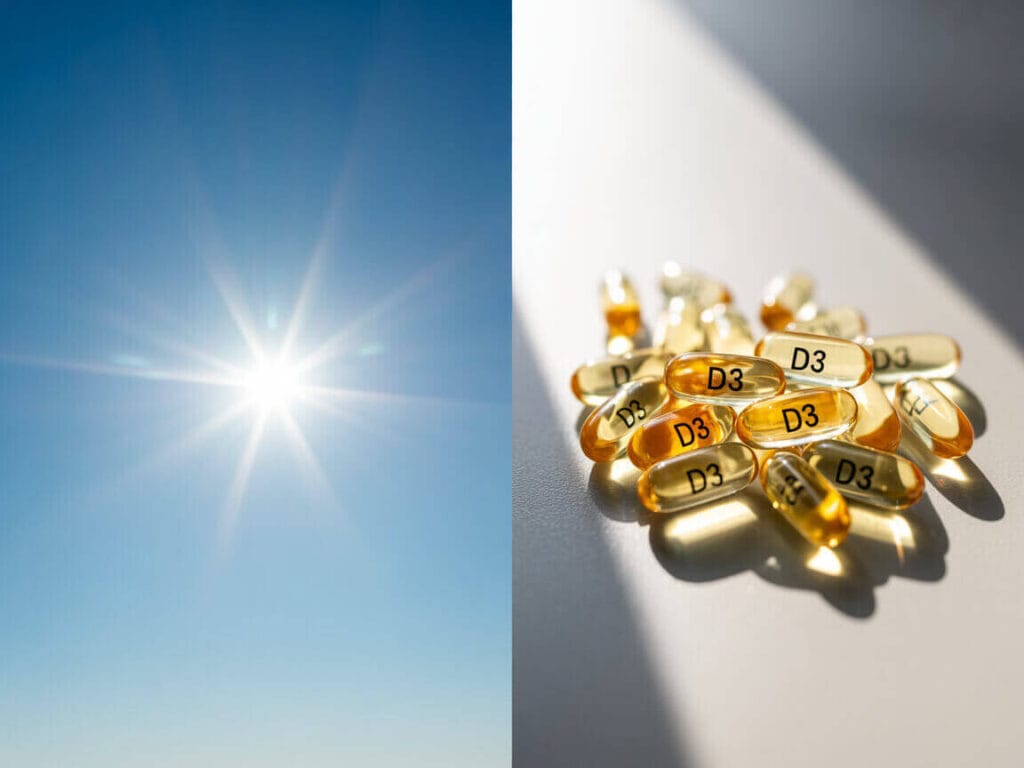Did you know vitamin D acts like sunshine inside your body? It’s essential not only for keeping your bones strong, but also for helping your immune system work properly and supporting your mood. Achieving optimal vitamin D levels can help you maintain these important functions and reduce your risk of problems like fatigue, infections, or osteoporosis. The good news is that it often starts with something as simple as a few minutes of sun exposure each day.
What Are Optimal Vitamin D Levels?
Experts from the Endocrine Society recommend that optimal vitamin D levels be between 30–50 ng/mL, which is considered the sweet spot for supporting bone health, immunity, and other vital functions. Levels below 20 ng/mL are classified as deficient and should be discussed with your healthcare provider so you can decide on the right approach for getting back on track.
Sunlight vs Supplements

Sunlight
- Sunlight is by far the most natural, efficient, and enjoyable way to get vitamin D. Just 10 minutes of direct sun exposure each day before 10 a.m. or after 4 p.m. on your face, arms, and legs can be enough for many healthy adults to maintain adequate levels, while also reducing the risk of skin damage from stronger midday UV rays.
- In ideal conditions — such as during spring or summer with clear skies — this daily sun exposure can boost your vitamin D by 10-20 ng/mL within a few weeks, depending on your skin tone and other factors.
- However, not everyone makes vitamin D at the same rate. Factors like where you live (northern vs. southern regions), your skin color (darker skin needs more time in the sun), the time of year, cloud cover, and sunscreen use can dramatically reduce how much vitamin D your body produces.
- Remember: brief, regular sun exposure during these safer hours is usually enough for vitamin D, but you should always balance it with skin cancer prevention — avoid prolonged sunbathing or intentional tanning.
Supplements
- Supplements can be a reliable option for people who don’t get enough sunlight. This includes those who live in northern latitudes with long winters, work indoors all day, cover most of their skin for personal or cultural reasons, or have darker skin and limited sun exposure.
- Supplements are also useful for people with health conditions that interfere with vitamin D absorption, like certain gastrointestinal diseases or after bariatric surgery.
- But because excessive vitamin D can cause health problems like high blood calcium (hypercalcemia), you should always check with your doctor before starting or adjusting supplements.
When Should You Test Vitamin D Levels?

Routine testing isn’t necessary for everyone. However, it might be appropriate if you need to check whether you have optimal vitamin D levels or if you:
- Feel unusually tired, weak, or experience bone pain without a clear cause.
- Have a history of frequent fractures or osteoporosis at an early age.
- Suffer from medical conditions that reduce nutrient absorption, like Crohn’s disease, celiac disease, or cystic fibrosis.
- Take medications such as anticonvulsants or steroids that interfere with vitamin D metabolism.
- Have darker skin and live in areas with long winters or limited sunlight exposure.
- Are an older adult or spend most of your time indoors due to health, mobility, or caregiving needs.
It’s a good idea to talk with your healthcare provider if you think testing might help you better understand your health — many insurance plans will cover vitamin D testing if your doctor orders it.
Fun & Surprising Vitamin D Facts

🌞 About 80–90% of the vitamin D in your body comes from sunlight, not food. That’s why vitamin D is sometimes called the “sunshine vitamin.” Often, reaching optimal vitamin D levels depends on getting enough safe sun exposure regularly.
🥚 Foods like fatty fish (salmon, sardines), egg yolks, and fortified milk provide some vitamin D, but they’re usually not enough on their own to keep your levels optimal, especially during winter.
🔬 Vitamin D behaves more like a hormone than a typical vitamin. After your skin makes or you ingest it, vitamin D travels to your liver and kidneys, where it’s converted into its active form. Once activated, it helps regulate calcium levels, supports immune function, and plays a role in over 200 genes that impact your health.
🩺 Did you know vitamin D may help reduce the risk of autoimmune diseases by supporting immune system regulation? Studies show vitamin D deficiency or impaired vitamin D metabolism can affect the onset and severity of autoimmune conditions, highlighting the importance of maintaining healthy levels (Dipasquale et al., 2022).
Important Notes
- This article is meant for educational purposes only and should not be used as a substitute for personalized medical advice, diagnosis, or treatment.
- People with specific health conditions like osteoporosis, kidney disease, or digestive disorders should work closely with their healthcare provider to determine whether testing or supplementation is needed.
- Always check with your doctor or a qualified health professional before starting vitamin D supplements, especially if you plan to take more than standard over-the-counter doses.
Want to stay healthy? See how sleep affects your wellness in Can Lack of Sleep Raise Blood Sugar? and discover how daily habits impact your body.









